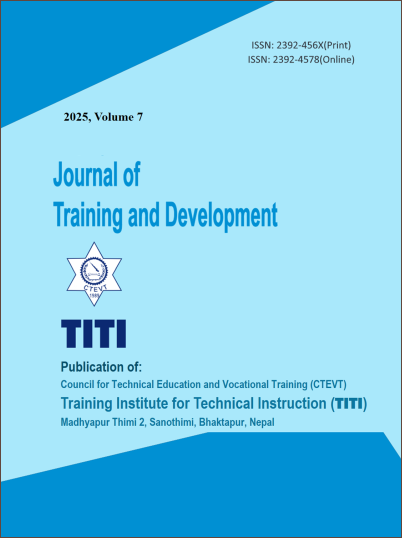TVET in Nepal: Scope and the Associated Challenges
DOI:
https://doi.org/10.3126/jtd.v7i1.74979Keywords:
TVET, Technical Schools, Pragmatism, ProgressivismAbstract
Technical and vocational education and training (TVET) equips individuals with specific skills required for the job market. It also provides a workforce that is needed for employment generation, entrepreneurship, and industrial growth. During the pre-agricultural stage of society, human beings used to practice the on-the-job phenomenon to learn the basic and necessary skills required for survival and cultural continuity. As society changed, vocational education also evolved in the form of formal and informal apprenticeships, oral tradition, and experiential learning. In Nepal, the establishment of the Council for Technical Education and Vocational Training (CTEVT) officially ensured that long and short courses offered by technical schools produce skillful human resources that are needed for the economic growth of the country.
Despite the growth in technical schools across the years, this article shows that TVET has not been able to bridge the gap between demand and supply of the workforce. This article has used secondary data to examine the status of population demographics and employment rate and also has explored the enrolment capacity versus actual enrollment in technical schools. In addition, this study has also explored the status of instructors in technical schools. Based on the secondary data, this study concludes that there is a need for a nationwide debate along with a plan of action to improve all aspects of TVET programs if Nepal aims to cultivate self-reliant and self-employed individuals as a way of reducing unemployment in the country.
Downloads
Downloads
Published
How to Cite
Issue
Section
License

This work is licensed under a Creative Commons Attribution 4.0 International License.
Authors who publish with this journal agree to the following terms:
- Authors retain copyright and grant the journal right of first publication with the work simultaneously licensed under a Creative Commons Attribution License that allows others to share the work with an acknowledgement of the work's authorship and initial publication in this journal.
- Authors are able to enter into separate, additional contractual arrangements for the non-exclusive distribution of the journal's published version of the work (e.g., post it to an institutional repository or publish it in a book), with an acknowledgement of its initial publication in this journal.
- Authors are permitted and encouraged to post their work online (e.g., in institutional repositories or on their website) prior to and during the submission process, as it can lead to productive exchanges, as well as earlier and greater citation of published work (See The Effect of Open Access).




